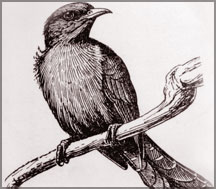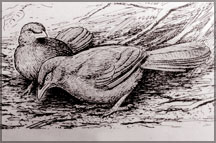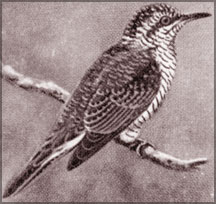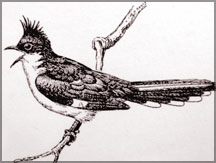Nesting secrets of the cuckoos
by K.G.H. Munidasa
Out of the eleven forms of Parasitic Cuckoos, which are known to
occur in Sri Lanka, only five have been admitted to the island's
check-list as breeding residents. The rest are migrants to the island
during the winter period.
A sixth, the Indian Cuckoo (Cuculus micropterus) has meanwhile been
labelled as "Status Uncertain," though "there is evidence that,
occasionally, at least, it breeds in the island and "its young have been
found in the nests of the Ceylon black-headed Oriole."
|

Drongo cuckoo |
The late S.V.O. Somanader, posing the question of this elusive bird
in 1967 suggested "its fosterers may be found among the Paradise
Flycatcher or the Drongos, or even the Black-headed Oriole"... Cicely
Lushington in her book Bird Life in Ceylon records that "an Oriole was
once seen feeding a young cuckoo, which probably belonged to this
species."
However, in 1982 the Ceylon Bird Club placed on record authentic
evidence that proved, once and for all, that the Black-headed Oriole is
the local fosterer of this cuckoo.
The best known of all resident cuckoos is the Indian Koel (Eudynamys
scolopacea), which is parasitic on the two local crows, i.e. House crow
and the Black crow. The koel's egg is described as grayish-green,
spotted with reddish brown.
It measures 30.6 x 22.9 mm. against 36 x 27 mm. (House crow) and 42 x
29 mm. (Black crow). The crows' eggs however are said to be brighter in
ground colour.
|

Common Ceylon Babbler - Most popular fosterer |
The Ceylon Hawk Cuckoo (Cuculus varius ciceliae) and the Pied Crested
Cuckoo (Clamator jacobinus) are both parasitic species which, as far as
the records prove, victimize the Common Ceylon Babbler or the "Seven
Sisters".
Both of them lay turquoise-blue eggs, which tally closely with those
of the host speices, but slightly the larger in size.
The Indian race of the former is said to cuckold small birds like
pipits and chats, while the latter bulbuls, and various members of the
Babbler family.
The breeding season of the Pied crested Cuckoo is as extended as that
of its host species the Common Babbler.
At times two or even three cuckoo eggs have been taken from a single
babbler's nest. They measure 24 x 19 mm. against 23.8 x 18.4 mm. of the
babbler.
In 1968, the writer came upon a baby Crested Cuckoo being brought up
by the Common Babblers, in the suburbs of the Ampara town. There were
five to six babblers in the group, while two of them attended on the
foster child, the others foraged in the undergrowth.
|

Bay-banded cuckoo |
The cuckoo was unlike any young babbler (there wasn't any in
evidence) that even an inexperienced bird-student would have at once
noticed the difference in coloration, while it sat there on a sprig
demanding food from the two foster parents. It was gray and buff-white
with dirty white wing patches (white in the adult cuckoo) clearly
visible on the side of wings.
Since the adult Ceylon Drongo Cuckoo (Surniculus lugubris stewarti)
closely resembled the Ceylon Common Drongo, it was formerly believed
that it deposited its eggs in the nest of that bird. However, W.E. Wait
later obtained authentic evidence that went to prove that in its
breeding habits the Drongo Cuckoo victimized the Black-fronted Babbler.
In 1917 wait recovered a nest of this babbler from the Puttalam
district, tenanted by a nestling of the Drongo Cuckoo. On a previous
occasion, too he had taken a strange egg from a nest of the same species
of babblers, which he tentatively assigned to the this cuckoo.
In June 1970, at an old village not far from the Hingurana sugar
factory, the writer happened to examine a nest of the White-throated
Babbler.
It contained a clutch of three speckled eggs of which two were
identical in all respects, but the other was seemingly different in
shape, being very elliptical.
|

Pied-crested cuckoo |
Later a thorough examination of the two egg specimens under a bright
light revealed, though the ground colour of both was white, the strange
egg gave out a pink glow, the other being chalky-white. The first egg
measured 16 x 13 mm. against 18 x 13 of the other.
Henry gives the measurement of the egg of White-throated Babbler as
18 x 13.7 mm, and glossy-white in ground colour, with speckles of
brownish-red. In May 1975, Shirley Perera of the Department of Wildlife
Conservation watched a juvenile of the Drongo Cuckoo being fed by this
species of babblers in the jungles of Mullegama off Inginyagala.
It is also on record that about 50 years ago a nestling of the Drongo
Cuckoo was found in a nest of the White-browed Prinia -a member of the
warbler family, not much larger than the Ceylon Tailor Bird.
The White-browed Prinia builds a small pouched-shaped nest out of
grass strips, domed over at the top, and attached to a grass tussock or
low branch.
Its egg is coloured a rich turquoise-blue, with spots and blotches of
chocolate-brown. G.M. Henry suggests that the Drongo Cuckoo may also
possibly lay its eggs in the nest of the Ceylon Iora, which builds a
cup-like nest, usually in an open dead branch in the forest canopy. Its
egg is described as matt-white, with markings of slaty-grey and brown.
The Ceylon Bay-banded Cuckoo (Cacomantis sonnerati waiti) is a race
peculiar to Sri Lanka, whose breeding is practically unknown. However,
it is believed that this race of cuckoos generally laid its eggs in the
nests of the Orange Minivet and the Small Minivet.
"In September 1940 Cicely Lushington watched a female of the Orange
Minivet feeding a fledgling of this cuckoo." The Indian race is known to
cuckold various bulbuls and babblers. So most likely these birds will
prove to be the normal fosterers of the local race, too. |
